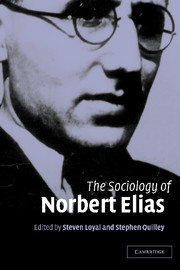Book contents
- Frontmatter
- Contents
- List of contributors
- Acknowledgements
- 1 Towards a ‘central theory’: the scope and relevance of the sociology of Norbert Elias
- Part I Sociology as a human science: Norbert Elias and the sociology of knowledge
- Part II Processes of stratification: figurations of race, class and gender
- 5 Aspects of the figurational dynamics of racial stratification: a conceptual discussion and developmental analysis of black–white relations in the United States
- 6 Decivilizing and demonizing: the remaking of the black American ghetto
- 7 Elias on class and stratification
- 8 Elias on gender relations: the changing balance of power between the sexes
- Part III The formation of individuals and states
- Part IV Religion and civilizing processes: Weber and Elias compared
- Index
- References
6 - Decivilizing and demonizing: the remaking of the black American ghetto
Published online by Cambridge University Press: 22 September 2009
- Frontmatter
- Contents
- List of contributors
- Acknowledgements
- 1 Towards a ‘central theory’: the scope and relevance of the sociology of Norbert Elias
- Part I Sociology as a human science: Norbert Elias and the sociology of knowledge
- Part II Processes of stratification: figurations of race, class and gender
- 5 Aspects of the figurational dynamics of racial stratification: a conceptual discussion and developmental analysis of black–white relations in the United States
- 6 Decivilizing and demonizing: the remaking of the black American ghetto
- 7 Elias on class and stratification
- 8 Elias on gender relations: the changing balance of power between the sexes
- Part III The formation of individuals and states
- Part IV Religion and civilizing processes: Weber and Elias compared
- Index
- References
Summary
This chapter is divided into two parts. In Part I, I analyse the post-sixties transformation of America's black ghetto in material reality and public discourse as the product of two interconnected processes. At the social-relational level, the ghetto has undergone a process of ‘de-civilizing’ in Elias's sense of the term, caused not by economic ‘mismatches’, the excessive generosity of welfare, or the ‘culture of poverty’ and ‘anti-social’ impulses of its residents, but by the withdrawal of the state and the ensuing disintegration of public space and social relations in the urban core. This process is echoed, at the symbolic level, by the demonization of the black sub-proletariat via the trope of the ‘underclass’, a scholarly myth anchored by the loathsome imagery of the fearsome ‘gang banger’ and the dissolute ‘welfare mother’. Decivilizing and demonization form a structural-cum-discursive couplet in which each element reinforces the other and both serve in tandem to legitimize the state policy of urban abandonment and punitive containment responsible for the parlous state of the contemporary ghetto.
In Part II this processual approach to the formation of class, caste and urban space is further elaborated using the theoretical tools of Norbert Elias's figurational sociology.
- Type
- Chapter
- Information
- The Sociology of Norbert Elias , pp. 95 - 121Publisher: Cambridge University PressPrint publication year: 2004
References
- 50
- Cited by



